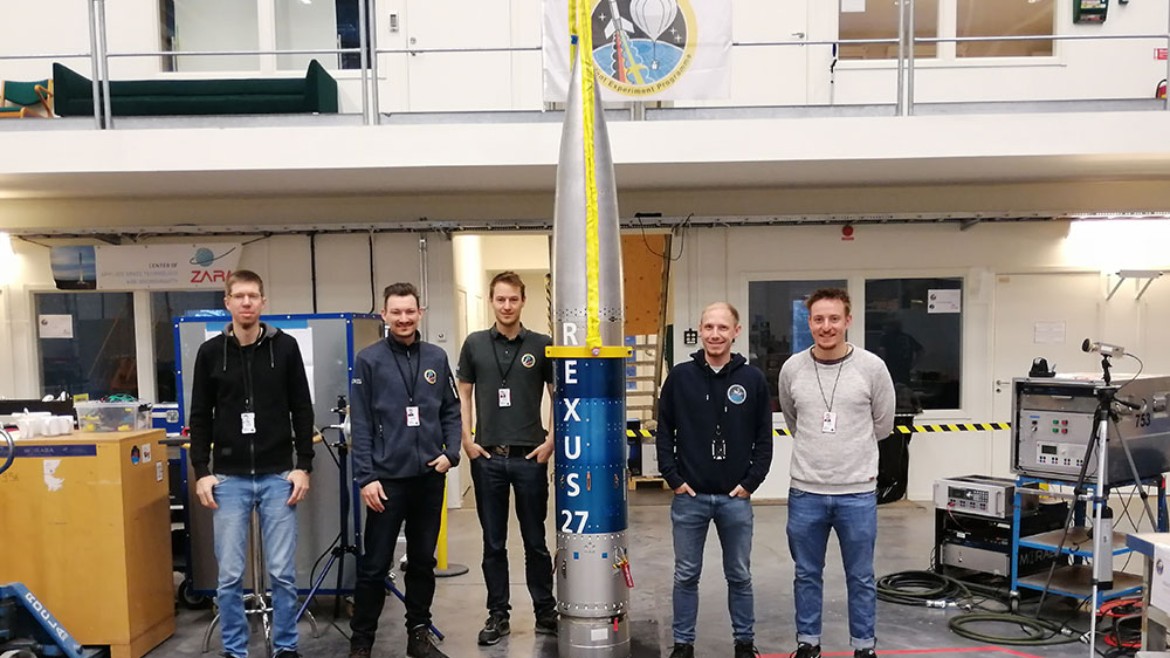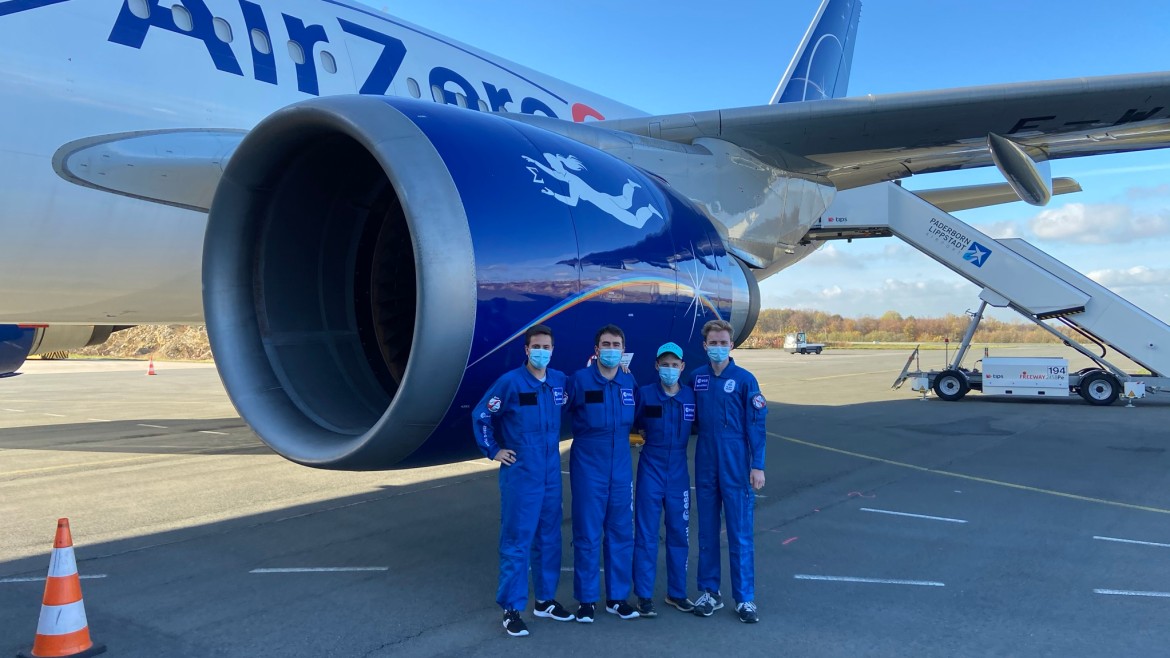SPACE LAB - In-Space Manufacturing
Seit 2018 treibt das SPACE LAB an der Hochschule München die Innovation im Bereich In-Space Manufacturing voran, womit es die Kosten und Abhängigkeit der Raumfahrt von Erdtransporten reduzieren möchte.
3D-Druck im Weltraum
So funktioniert In-Space Manufacturing
Studentische Projekte: Additive Fertigung im Weltraum
Teams des Labs fertigen Großstrukturen direkt im Weltall mit additiven Techniken, anstatt sie als Faltkonstruktionen zu launchen. Dies verspricht effizientere und stabilere Strukturen und öffnet neue Wege für Raumfahrtmissionen.

TEAM AIMIS-REXUS
Als Teil des REXUS-Programms, das vom Deutschen Zentrum für Luft- und Raumfahrt (DLR), der Schwedischen Nationalen Raumfahrtbehörde (SNSA) und der Europäischen Weltraumorganisation (ESA) organisiert wird, haben diese sieben Studierenden Neuland betreten. Im Rahmen dieses Raketenprogramms brachten die Studierenden das Potenzial des 3D-Drucks in den Orbit – eine Premiere für die Hochschule München. Mit einer Höhenforschungsrakete führten sie eine wegweisende Technologiedemonstration im All durch, bei der ein photoreaktives Polymer in Schwerelosigkeit extrudiert und mittels UV-Licht ausgehärtet wurde, vollkommen autonom und begleitet von einer Datenerhebung und Filmdokumentation.

TEAM AIMIS-FYT
Das engagierte Studierendenteam AIMIS-FYT der ESA sicherte sich 2019 einen Platz im FlyYourThesis!-Programm. Ein Meilenstein, der ihnen ermöglichte, ihre Forschung zum 3D-Druck von Photopolymeren unter Schwerelosigkeit sowie Mond- und Marsgravitation zu intensivieren.
Während zweier ESA-Parabelflugkampagnen nahm das Team an sechs Flügen teil. Durch die enge Zusammenarbeit mit Novespace-Ingenieuren und ESA-Projektleitern entwickelten die Studierenden innerhalb eines Jahres einen betriebsbereiten 3D-Drucker.
Diese Flüge demonstrierten erfolgreich, dass der 3D-Druckprozess auch ohne Schwerkraft funktioniert. Begleitet von zwei Teammitgliedern im Airbus A310, führten sie Experimente durch, sicherten gedruckte Strukturen und dokumentierten die Ergebnisse.
Durch ihre Teilnahme an 184 Parabeln machten sie bedeutende Fortschritte im Bereich des Weltraum-3D-Drucks.

TEAM PERSIS-REXUS
PERSIS – kurz für Photopolymeric Extrusion of Reinforced Structures in Space – ist ein Projekt von 15 Studierende der Hochschule München und der Technischen Hochschule München. Es wird im Rahmen des REXUS Programms durchgeführt, das vom Deutschen Zentrum für Luft- und Raumfahrt (DLR) und der Schwedischen Nationalen Raumfahrt-Behörde (SNSB) organisiert wird. Dieses Programm erlaubt es Studierenden aus Europa und Kanada, wissenschaftliche Experimente auf Höhenforschungsraketen durchzuführen.
Das PERSIS-Projekt wird im März 2025 mit der Rakete RX33 starten und hat das Ziel, vier kohlefaserverstärkte Profile im Weltraum herzustellen. Diese werden durch Extrusion eines photopolymeren Harzes und Aushärtung mit UV-Licht geformt. Das Projekt untersucht In-Space-Manufacturing, das Vorteile gegenüber dem Transport fertiger Strukturen hat, wie größere Flexibilität und weniger Gewicht. Es vermeidet komplexe Faltmechanismen und reduziert die Belastung der Strukturen beim Raketenstart.
Die vier Profile, die PERSIS herstellen wird, sind jeweils 70 mm lang. Das Team wird sich zwei Wochen in der European Space and Sounding Rocket Range (ESRANGE) in Nord-Schweden aufhalten, um das Experiment vorzubereiten und auszuwerten.
Co-funded Research
Seit Anfang 2022 findet eine co-finanzierte Forschung zwischen der Europäischen Weltraumorganisation (ESA) und dem Satellitensubsystemhersteller DcubeD zur additiven Fertigung von externen Satellitenstrukturen an der Hochschule München statt (ESA Contract No. 4000136187).
Seit Anfang 2024 arbeiten der Satellitensubsystemhersteller DcubeD und die Hochschule München gemeinsam am MASS-PEX-Projekt. Dabei werden Methoden und neue Komponenten für die Fertigung von Satellitenstrukturen direkt im All erforscht und entwickelt. Die Finanzierung des Projekts erfolgt durch das Bayerische Staatsministerium für Wirtschaft, Landesentwicklung und Energie (StMWi).
Ziel dieser Forschung ist es, die Grundlage zu schaffen, um in Zukunft externe Satellitenstrukturen direkt im Weltraum mittels Photopolymeren herstellen zu können.


English Version
SPACE LAB - In-Space Manufacturing
Since 2018, the SPACE LAB at Munich University of Applied Sciences has been driving innovation in the field of in-space manufacturing, aiming to reduce the costs and dependency of space missions on Earth-based transportation.
3D Printing in Space - Video
Student projects
Teams at the lab are manufacturing large structures directly in space using additive techniques, rather than launching them as folded constructions. This promises more efficient and stable structures, opening new possibilities for space missions.

TEAM AIMIS-REXUS
AIMIS-REXUS is a student team established in 2018 at Munich University of Applied Sciences and part of the SPACE LAB. AIMIS stands for "Additive Manufacturing In Space," focusing on a specific 3D printing method to manufacture components such as solar panels or antennas directly in space under microgravity conditions.
As part of the REXUS program, these seven students are breaking new ground by bringing the potential of 3D printing into orbit, a first for Munich University of Applied Sciences. Using a REXUS rocket, they conducted a groundbreaking technology demonstration in space, extruding a photoreactive polymer in microgravity and curing it using UV light autonomously, while documenting the process through data collection and camera footage.

TEAM AIMIS-FYT
In 2019, the dedicated student team AIMIS-FYT of the European Space Agency (ESA) achieved a significant milestone by securing a place in the esteemed FlyYourThesis! program. This opportunity allowed aspiring scientists to advance their research on 3D printing of photopolymers under microgravity conditions, as well as lunar and Martian gravitation.
During two ESA parabolic flight campaigns, the team participated in a total of six flights. Their close collaboration with engineers from Novespace and project leaders from ESA, enabled them to develop a fully operational 3D printer within less than a year. This instrument was crucial for successfully conducting their planned experiments.
These flights impressively demonstrated the capability of the 3D printing process to create various structures even in zero-gravity environments.
With two team members aboard the Airbus A310, they initiated experiments, secured printed structures, and documented the results. By participating in 184 parabolas, the student team became part of a visionary initiative shaping the future of space 3D printing.

TEAM PERSIS-REXUS
PERSIS - short for Photopolymeric Extrusion of Reinforced Structures in Space - is a project involving 15 students from Munich University of Applied Sciences and the Technical University of Munich. It is being carried out as part of the REXUS programme, which is organized by the German Aerospace Center (DLR) and the Swedish National Space Board (SNSB). This program allows students from Europe and Canada to conduct scientific experiments on sounding rockets.
The PERSIS project will launch on the RX33 rocket in March 2025 and aims to produce four carbon fiber-reinforced profiles in space. These will be formed by extruding a photopolymer resin and curing with UV light. The project investigates in-space manufacturing, which has advantages over transporting finished structures, such as greater flexibility and less weight. It avoids complex folding mechanisms and reduces the load on the structures during rocket launch.
The four profiles that PERSIS will produce are each 70 mm long. The team will spend two weeks at the European Space and Sounding Rocket Range (ESRANGE) in northern Sweden to prepare and evaluate the experiment.
Co-Funded Research
Since the beginning of 2022, Munich University of Applied Sciences has been conducting co-funded research in collaboration with the European Space Agency (ESA) and satellite subsystem manufacturer DcubeD. This initiative focuses on advancing additive manufacturing techniques for external satellite structures (ESA Contract No. 4000136187).
Satellite subsystem manufacturer Dcubed and Munich University of Applied Sciences are working together on the MASS-PEX project since early 2024. This involves researching and developing methods and new components to produce satellite structures directly in space. The project is funded by the Bavarian State Ministry of Economic Affairs, Regional Development and Energy (StMWi).
The primary goal of this research is to establish the foundation for manufacturing external satellite structures directly in space using photopolymers in the future.

